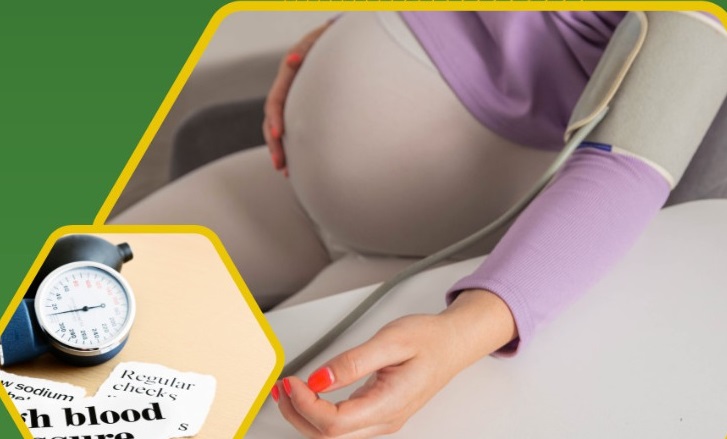The application of Mississippi Protocol in superimposed pre-eclampsia patients with class 2 hemolysis, elevated liver enzymes, and low platelet count (HELLP) syndrome

Downloads
HIGHLIGHTS
- The neonatal outcome following pregnancy termination was preterm birth, accompanied by low birth weight and respiratory distress.
- Following pregnancy termination, laboratory parameters gradually demonstrated improvement over time.
- Mississippi Protocol therapy was maintained for 4 days after pregnancy termination until both clinical status and laboratory values showed improvement.
ABSTRACT
Objective: To describe the implementation of the Mississippi Protocol (MP) in a case of superimposed pre-eclampsia complicated by class 2 HELLP syndrome.
Case Report: The patient initially received conservative treatment, including anticonvulsant prophylaxis, antihypertensive agents, and high-dose cortico-steroids, in accordance with the MP. However, during observation, placental abruption and fetal distress were noted. Consequently, an emergency (green code) Caesarean section was performed. Placental abruption is a known complication associated with pre-eclampsia. The neonatal outcome following pregnancy termination was premature birth, low birth weight, and respiratory distress. Following delivery, laboratory parameters gradually improved. MP therapy was continued for 4 days post-delivery until clinical and laboratory indicators normalized. The administration of high-dose corticosteroids in HELLP syndrome is based on its characteristic excessive inflammatory response, which represents the distinctive feature of this case. Corticosteroid therapy is intended to reduce maternal morbidity and mortality and to enhance neonatal outcomes.
Conclusion: Careful monitoring and comprehensive management are essential when applying the MP in such cases. The definitive treatment for both pre-eclampsia and HELLP syndrome remains the termination of pregnancy. Further research is required to assess the effectiveness of MP in emergency or complicated scenarios.
Mayrink J, Costa ML, Cecatti JG. Preeclampsia in 2018: Revisiting concepts, physiopathology, and prediction. ScientificWorldJournal. 2018;2018: 626 8276. doi: 10.1155/2018/6268276. PMID: 3062 2442; PMCID: PMC6304478.
Vousden N, Lawley E, Seed PT, et al. Incidence of eclampsia and related complications across 10 low- and middle-resource geographical regions: Secon-dary analysis of a cluster randomised controlled trial. PLoS Med. 2019;16(3):e1002775. doi: 10.1371/journal.pmed.1002775. PMID: 30925 157; PMCID: PMC6440614.
Burton GJ, Redman CW, Roberts JM, et al. Pre-eclampsia: pathophysiology and clinical implica-tions. BMJ. 2019;366:l2381. doi: 10.1136/bmj. l2381. PMID: 31307997.
Abalos E, Cuesta C, Carroli G, et al. Pre-eclampsia, eclampsia and adverse maternal and perinatal outcomes: a secondary analysis of the World Health Organization Multicountry Survey on Maternal and Newborn Health. BJOG. 2014;121 Suppl 1:14-24. doi: 10.1111/1471-0528.12629. PMID: 24641531.
Nakakita B, Ueda A, Chigusa Y, et al. Modified Mississippi protocol for HELLP/partial HELLP syndrome occurring in the periviable period: A report of three cases. Hypertens Res Pregnancy. 2020;8(1):22–5. doi: 10.14390/jsshp.HRP2019-017.
Pritchard NL, Keane JL. Wound haematoma: The first sign in a case of late postpartum HELLP syndrome. Case Rep Womens Health. 2015;8:1-3. doi: 10.1016/j.crwh.2015.08.001. PMID: 296293 10; PMCID: PMC5885994.
Townsend R, O'Brien P, Khalil A. Current best practice in the management of hypertensive disorders in pregnancy. Integr Blood Press Control. 2016;9:79-94. doi: 10.2147/IBPC.S77344. PMID: 27555797; PMCID: PMC4968992.
Rădulescu C, Bacârea A, Huțanu A, et al. Placental growth factor, soluble fms-like Tyrosine Kinase 1, soluble endoglin, IL-6, and IL-16 as biomarkers in preeclampsia. Mediators Inflamm. 2016;2016:3027 363. doi: 10.1155/2016/3027363. Epub 2016 Oct 5. PMID: 27799724; PMCID: PMC5069373.
Guedes-Martins L. Superimposed preeclampsia. Adv Exp Med Biol. 2017;956:409-417. doi: 10.1007/5584_2016_82. PMID: 27722963.
Fox R, Kitt J, Leeson et al. Preeclampsia: Risk factors, diagnosis, management, and the cardio-vascular impact on the offspring. J Clin Med. 2019; 8(10):1625. doi: 10.3390/jcm8101625. PMID: 31590294; PMCID: PMC6832549.
Adorno M, Maher-Griffiths C, Grush Abadie HR. HELLP Syndrome. Crit Care Nurs Clin North Am. 2022;34(3):277-88. doi: 10.1016/j.cnc.2022.04.009. Epub 2022 Jul 20. PMID: 36049847.
Rimaitis K, Grauslyte L, Zavackiene A, et al. Diagnosis of HELLP Syndrome: A 10-year survey in a perinatology centre. Int J Environ Res Public Health. 2019;16(1):109. doi: 10.3390/ijerph160 10109. PMID: 30609811; PMCID: PMC6339138.
Petca A, Miron BC, Pacu I, et al. HELLP Syndrome-holistic insight into pathophysiology. Medicina (Kaunas). 2022;58(2):326. doi: 10.3390/ medicina58020326. PMID: 35208649; PMCID: PMC8875732.
Carvalho MA, Bejjani L, Francisco RPV, et al. Outcomes following medical termination versus prolonged pregnancy in women with severe preeclampsia before 26 weeks. PLoS One. 2021; 16(2):e0246392. doi: 10.1371/journal.pone.0246 392. PMID: 33534858; PMCID: PMC7857578.
Costa ML, Cavalli RC, Korkes HA, et al. Diagnosis and management of preeclampsia: Suggested guidance on the use of biomarkers. Rev Bras Ginecol Obstet. 2022;44(9):878-83. doi: 10.1055/s-0042-1744286. Epub 2022 Apr 25. PMID: 35468644; PMCID: PMC9948147.
Cox AG, Marshall SA, Palmer KR, et al. Current and emerging pharmacotherapy for emergency management of preeclampsia. Expert Opin Pharmacother. 2019;20(6):701-12. doi: 10.1080/ 14656566.2019.1570134. Epub 2019 Feb 1. PMID: 30707633.
Kemp MW, Newnham JP, Challis JG, et al. The clinical use of corticosteroids in pregnancy. Hum Reprod Update. 2016;22(2):240-59. doi: 10.1093/ humupd/dmv047. Epub 2015 Nov 20. PMID: 26590298.
Chawla S, Wyckoff MH, Rysavy MA, et al. Association of antenatal steroid exposure at 21 to 22 weeks of gestation with neonatal survival and survival without morbidities. JAMA Netw Open. 2022;5(9):e2233331. doi: 10.1001/jamanetwork open.2022.33331. PMID: 36156145; PMCID: PMC 9513645.
Nayeri UA, Buhimschi IA, Laky CA, et al. Antenatal corticosteroids impact the inflammatory rather than the antiangiogenic profile of women with preeclampsia. Hypertension. 2014;63(6):1285-92. doi: 10.1161/HYPERTENSIONAHA.114.031 73. Epub 2014 Mar 24. PMID: 24664292.
Lokki AI, Haapio M, Heikkinen-Eloranta J. Eculizumab treatment for postpartum HELLP syndrome and aHUS-Case report. Front Immunol. 2020;11:548. doi: 10.3389/fimmu.2020.00548. PMID: 32308654; PMCID: PMC7145984.
Nie X, Xu Z, Ren H. Analysis of risk factors of preeclampsia in pregnant women with chronic hypertension and its impact on pregnancy outcomes. BMC Pregnancy Childbirth. 2024;24(1) :307. doi: 10.1186/s12884-024-06476-1. PMID: 38658851; PMCID: PMC11040943.

This work is licensed under a Creative Commons Attribution-NonCommercial-ShareAlike 4.0 International License.
1. Copyright of the article is transferred to the journal, by the knowledge of the author, whilst the moral right of the publication belongs to the author.
2. The legal formal aspect of journal publication accessibility refers to Creative Commons Attribution-Non Commercial-Share alike (CC BY-NC-SA), (https://creativecommons.org/licenses/by-nc-sa/4.0/)
3. The articles published in the journal are open access and can be used for non-commercial purposes. Other than the aims mentioned above, the editorial board is not responsible for copyright violation
The manuscript authentic and copyright statement submission can be downloaded ON THIS FORM.



















